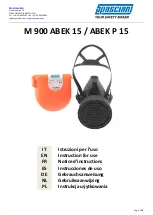
28
© 2012 by Proceq SA
6.12 Chipping graph
After having accessed the cumulative frequency graph, the “Potential Map” button becomes active.
By clicking on it, the visualization switches to the chipping graph (see Fig. 6.10).
The four colour regions of the chipping graph are based upon the three cursor positions in the
cumulative frequency graph.
These positions represent potential limits identified by the engineer as areas of equal condition where
the concrete has to be chipped to a certain depth for repair purposes.
Fig. 6.10: Chipping graph
6.13 Annotations
Information about the concrete structure like measured chloride content, cracks or other defects
can be placed directly in the potential map or the chipping graph. The information will be printed
and shown in bitmaps.
By default they are created with an arrow that can be moved to point at a specific spot in the graph.
Annotations can be added by right clicking on the potential map or chipping graph and selecting
“Create Annotation”.
Fig. 6.11: Annotation window
Fig. 6.12: Annotation Attributes
Right click on an annotation to select its attributes. If the Lock Name attribute is not selected, the
entire annotation (point, label and arrow) can be moved by left clicking on the annotation and drag-
ging it around. If the Lock Name attribute is selected, the name will stay fixed and only the annotation
point with the arrow can be moved.









































